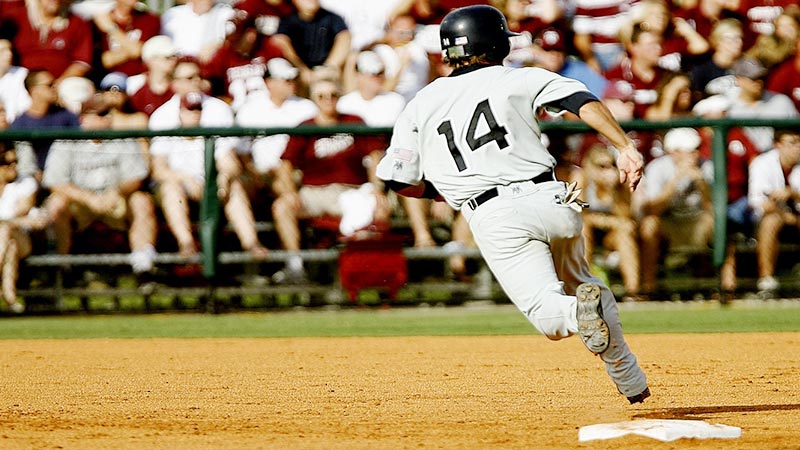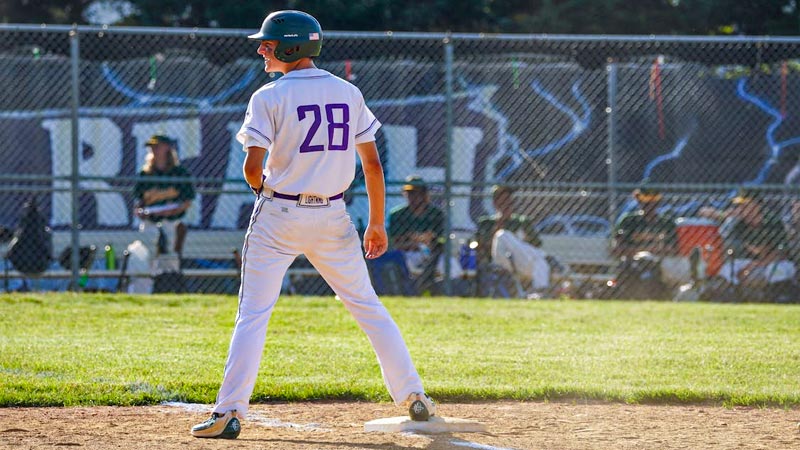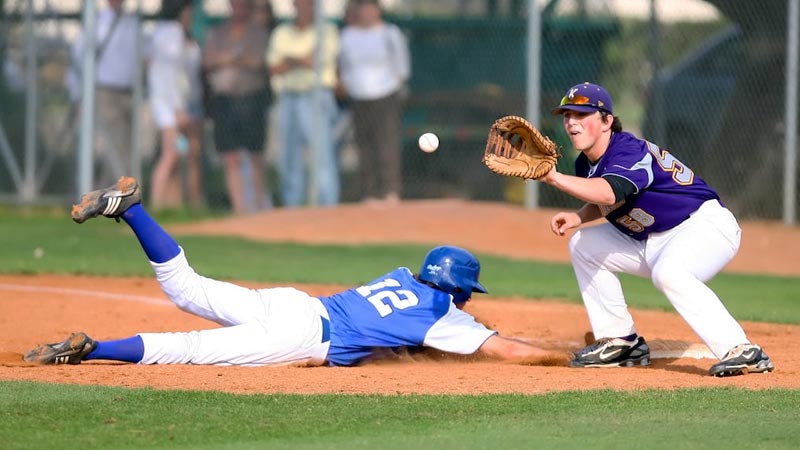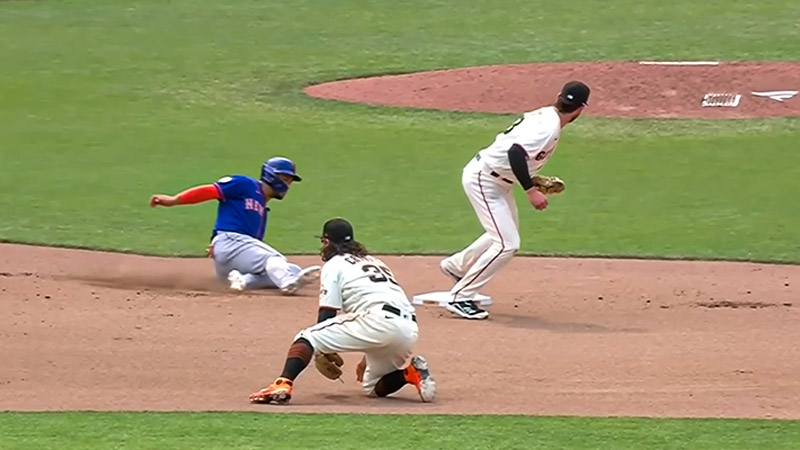In the game of baseball, base running is an essential aspect that can greatly influence the outcome of a match. It requires not only speed and agility but also a solid understanding of the rules governing base running.
By adhering to these rules, players can maximize their effectiveness on the base paths and contribute to their team’s success. So one has to abide by these rules to enjoy the game properly.
Basic Base Running Rules
There are some basic rules for base running and they had to be paid heed to. Check out below to know them in a nutshell.
Starting on a Base and Not Going Backward
When a player is on base, they must remain on that base until the ball is hit. It is crucial not to go backward, as this can result in being called out.
The purpose of this rule is to prevent runners from taking advantage of their starting position and trying to confuse the defense by retreating toward the previous base.
By enforcing this rule, the game ensures fair play and encourages runners to focus on advancing to the next base.
Touching Each Base in Order
As runners make their way around the bases, they must touch each base in the correct order. This rule ensures that runners have completed the necessary distance and have legally advanced to the next base.
Failure to touch a base can result in being called out, even if the runner crosses home plate. It is essential for runners to pay close attention to their base running path and make sure they make contact with each base along the way.
Running Back to a Base if Needed
Sometimes during a play, a runner may need to retreat to a previous base to avoid being tagged out. This commonly occurs when a batted ball is caught in the air, and the runner on the preceding base has advanced too far.
In such situations, the runner must quickly return to the previous base to establish their right to that base. Running back to a base is a crucial strategy in base running, as it allows runners to maintain their position and avoid being called out.
Additionally, fans can appreciate the skill and athleticism involved in base running, knowing that the players are following the rules that govern this aspect of the game.
Baseball is a sport where precision and adherence to the rules matter, and base running is no exception.
Allowed Base Paths
The base path is an imaginary line that connects each base on the field. It is the route that a runner must take to legally advance between bases. The base path is typically established by drawing a line three feet away from the direct line between bases.
This path provides runners with a clear route to follow while avoiding interference with fielders attempting to make plays. By staying within the base path, runners can ensure fair play and minimize the risk of collisions with defensive players.
Running Wide on Turns to Maintain Speed

When runners approach a base and intend to make a turn, it is often advantageous for them to run wide, away from the direct line between bases.
This strategy allows runners to maintain their momentum and speed while negotiating the turn.
By taking a wider path, runners can reduce the risk of slowing down or stumbling, giving them a better chance to reach the next base safely.
However, it is important to note that runners must still touch the base itself before proceeding to the next base, even if they have taken a wider path on the turn.
The Concept of the “Allowed Path” Approaching First Base
One unique rule in baseball pertains to the “allowed path” when approaching the first base. As a runner approaches first base from the right-hand side of the infield, they are required to remain within a three-foot-wide lane that extends from halfway between home plate and first base to the last 45 feet of the base path.
This rule prevents fielders from obstructing the runner’s path to first base and ensures fair play. If a runner interferes with a fielder’s ability to make a play by leaving this allowed path, they can be called out for interference.
By following the designated base paths and adhering to the rules surrounding turns and approaches to first base, runners can optimize their chances of advancing bases successfully and contributing to their team’s success.
Base running in baseball is not just about speed; it is also about precision and following the established paths that make the game fair and exciting.
Three-foot Rule and Tagging
The three-foot rule in baseball refers to the limit on how far a runner is allowed to deviate from the base path while running between bases. According to this rule, a runner must remain within three feet of the base path.
This restriction ensures fair play and prevents runners from taking a direct path to the next base, potentially obstructing fielders attempting to make plays.
By adhering to the three-foot rule, runners maintain an appropriate distance from fielders and reduce the likelihood of interference or collisions.
Consequences of Being Further Than Three Feet From the Base Path
If a runner strays more than three feet from the base path while running between bases, they can be tagged out by a defensive player with the ball.
This situation is often referred to as being “off the base path.” Once a runner is tagged while off the base path, they are considered out, regardless of whether they eventually return to touch the base.
Deviating from the three-foot limit not only exposes runners to the risk of being tagged out but also slows down their progress, as they may need to change direction or adjust their path to return to the base path.
Tagging and Its Impact on Base Running
Tagging plays a crucial role in base running and defense in baseball. When a runner is not on a base and a fielder with the ball touches them with the ball or with a glove holding the ball, the runner is considered “tagged.” Tagging can result in various outcomes depending on the situation.
If a runner is tagged before reaching a base, they are considered out. However, if the runner successfully reaches a base and is subsequently tagged while not touching the base, they can be tagged out as well.
Proper timing, agility, and strategic decision-making play significant roles in base runners’ ability to avoid being tagged and advance bases successfully.
Base running in baseball is a dynamic and strategic aspect of the game, and a firm grasp of these rules enhances players’ performance and contributes to the overall excitement of the sport.
Rules for Decoying a Fielder and Dodging Tags
Decoying a fielder and dodging tags are advanced base running techniques that require careful execution within the boundaries of the rules. When a runner approaches a base, they may attempt to deceive the fielder by altering their speed, direction, or body language to create a false impression of their intentions.
However, it is essential to note that excessive or deliberate fake movements intended to deceive fielders are considered a violation of the rules. The objective is to use subtle maneuvers and quick changes in direction to make it challenging for fielders to apply tags effectively.
By mastering these techniques, runners can keep fielders guessing and increase their chances of evading tags.
The Importance of Staying Within the Base Path

While decoying fielders and dodging tags can be advantageous, it is crucial for runners to remember the fundamental rule of staying within the base path.
The base path refers to the direct line between two bases, and runners must adhere to it to maintain fair play. Even during decoy attempts, runners should not deviate significantly from the base path to avoid obstructing fielders or creating unnecessary collisions.
By staying within the base path, runners ensure that fielders have a fair opportunity to apply tags, and they minimize the risk of interference penalties or being called out for deviating from the proper running path.
Exceptions for Avoiding Interference With Fielders
In certain situations, runners may be allowed to deviate from the base path to avoid interfering with fielders attempting to make plays. This exception applies when the fielder has the ball and is attempting to tag the runner.
In such cases, the runner is permitted to run away from the direct path between the bases to minimize contact or collision with the fielder. However, runners must take the most reasonable and direct route away from the fielder while still attempting to reach the next base.
It’s important to note that this exception is only applicable when the runner is actively avoiding interference with a fielder who possesses the ball and is attempting a tag.
Infield Fly Rule and Base Running
Some important infield fly rules for base running are mentioned in the following section.
Purpose of the Infield Fly Rule
The infield fly rule is in place to prevent infielders from intentionally dropping a fair fly ball in order to create a double-play opportunity. When an umpire invokes the infield fly rule, it declares the batter out regardless of whether the ball is caught or dropped by an infielder.
By calling the batter out, the rule eliminates the possibility of a deceptive play where the infielder could intentionally let the ball drop, quickly retrieve it, and initiate a double play by forcing out baserunners who are caught off guard.
The primary purpose of the infield fly rule is to ensure fair play and protect baserunners from being unfairly disadvantaged by such tactics.
Situations Where the Rule Does Not Apply
While the infield fly rule is an important aspect of the game, there are specific situations where the rule does not apply. The rule only comes into effect when there are fewer than two outs and runners on first and second base or the bases are loaded.
If there are no runners on base or if there is only a runner on third base, the infield fly rule does not apply. Additionally, the rule is not in effect when the ball is hit into the outfield.
It is important for players and fans to be aware of these exceptions to the infield fly rule to understand when it does and does not impact base running.
Impact on Base Running and Double Plays

The infield fly rule has a significant impact on base running and double-play situations. When the infield fly rule is invoked, baserunners are no longer forced to advance or hold their position as they would during a regular fly ball.
Since the batter is automatically out, runners are no longer in danger of being forced out if they leave their base before the ball is caught or dropped.
This changes the dynamics of base running, as runners can freely advance or retreat without the risk of being doubled off base. The infield fly rule eliminates the potential for infielders to exploit base running mistakes caused by deceptive infield fly situations.
Furthermore, the infield fly rule also affects double-play opportunities. With the batter automatically out, infielders are no longer required to tag the batter or throw to first base to complete a double play after catching the infield fly.
This alters the speed and execution of double-play attempts, as infielders can focus solely on tagging baserunners who may be trying to advance. As a result, the infield fly rule minimizes the likelihood of multiple outs being recorded on a single play and provides baserunners with more strategic options on the base paths.
Safe Vs. Unsafe
In baseball, the distinction between “safe” and “unsafe” is not used to describe base runner rules. The terms typically used are “safe” and “out.” Let’s explore these terms and how they relate to base running in baseball:
Safe
When a runner reaches a base without being tagged out or forced out, they are considered “safe.” Safe means that the runner successfully advanced to the base and remains in play. The runner can continue to stay on that base until the next play occurs or attempt to advance to the next base if they choose to do so.
Out or Unsafe
An “out” occurs when a runner is put out, either by being tagged with the ball while not touching a base or by being forced out. If the defensive team successfully tags a runner with the ball before they reach a base, the runner is declared “out.”
Additionally, if the defensive team possesses the ball and touches the base before the runner reaches it during a force play, the runner is also called “out.” A force play happens when a runner must advance to the next base because the batter becomes a runner or when there are already other runners occupying the bases.
While the terms “safe” and “out” are used in baseball, there is no specific term called “unsafe” related to base running. The focus is primarily on determining whether a runner successfully reaches a base or is put out according to the rules of the game.
Base Running Rules Summary
| Rule | Description |
| Starting on a base | Baserunners must begin on a base and not move backward, ensuring they maintain their position. |
| Touching each base in order | Baserunners must touch each base in the correct order while advancing around the bases. |
| Running back to a base | If a baserunner overruns a base or needs to retreat due to a play, they must return to the base. |
| Allowed Base Paths | Baserunners should follow the defined base path and take wide turns to maintain their speed. |
| The “allowed path” to 1st base | Baserunners approaching 1st base have an “allowed path” that allows them to avoid fielders’ interference. |
| Three-Foot Rule | Baserunners must stay within three feet of the base path to avoid being tagged out. |
| Consequences of straying | If a baserunner is further than three feet from the base path, they can be tagged out. |
| Tagging | Fielders must tag baserunners with the ball to record an out, influencing base running strategies. |
| Decoying and avoiding tags | Baserunners can use decoying techniques to confuse fielders and avoid being tagged out. |
| Staying within the base path | It is important for baserunners to stay within the base path to minimize the risk of interference. |
| Exceptions for fielder interference | There are certain exceptions where baserunners may deviate from the base path to avoid interfering with fielders. |
| Infield Fly Rule | The infield fly rule prevents infielders from exploiting base running situations and double plays. |
| Situations where the rule does not apply | The infield fly rule is not in effect in specific scenarios, such as when there are no runners on base or only a runner on third base. |
| Impact on base running and double plays | The infield fly rule affects base running strategies and alters the dynamics of double-play attempts. |
FAQs
What happens if a baserunner fails to touch a base?
If a baserunner fails to touch a base while advancing, they can be tagged out by the defensive team.
Can baserunners run on any pitch?
Baserunners can attempt to steal a base or advance on a pitch, but they must do so legally, following the base running rules.
Is there a maximum number of bases a baserunner can advance on an overthrow?
There is no maximum limit on how many bases a baserunner can advance on an overthrow. However, they must still touch each base in order.
Can baserunners collide with fielders while running the bases?
Baserunners should avoid collisions with fielders while running the bases. Interference with a fielder can result in an out for the baserunner.
What happens if a baserunner obstructs a fielder’s attempt to make a play?
If a baserunner obstructs a fielder’s attempt to make a play, the umpire may declare interference, resulting in the baserunner being called out.
Conclusion
Adhering to the base running rules in baseball is crucial for players to maximize their team’s offensive opportunities and minimize outs.
By knowing when to tag up, how to properly round the bases, and when to advance or hold their position, players can enhance their chances of scoring runs and contributing to their team’s success.
Moreover, avoiding mistakes such as missing bases or running out of the baseline is essential to maintain fair play and avoid unnecessary penalties.
By consistently practicing and mastering these base running fundamentals, players can elevate their overall performance and make meaningful contributions to the game.
Well, it’s time to leave for today. We’ll come back soon with something new and informative. Till then stay connected. Have a nice day.







